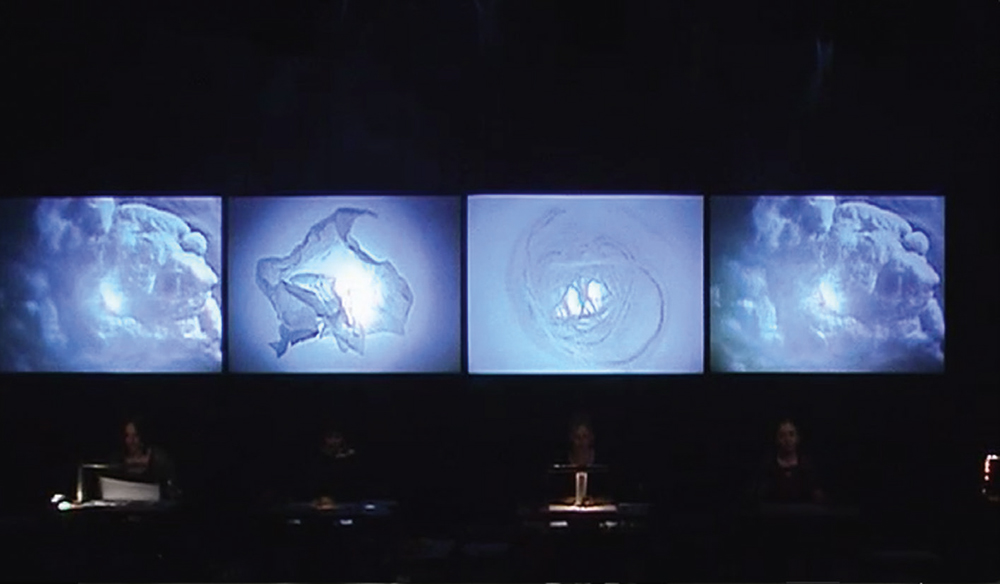Penelope Messidi is a doctoral candidate supervised by Martin Eybl at the mdw’s Department of Musicology and Interpretation Research. In the following, she provides mdw Magazine with some insights on her ongoing dissertation project, Georges Aperghis: Machinations.
The dissertation Georges Aperghis: Machinations delves into the first rendering of the music theatre work Machinations for four women and electronics by Georges Aperghis (2000) – a milestone in the oeuvre of a composer whose name is inseparably linked with the investigation and reinvigoration of the genre théâtre musical.
I am pursuing an interdisciplinary analytical approach that includes aspects of musicology, dramaturgy, philosophy, and linguistics in order to explore a string of questions pertaining to dramaturgy, the treatment of language beyond its semantic context, and the treatment of the human voice in a work that exhibits a high degree of complexity due in part to its employment of electronic media (tape and live electronics, video). Extensive attention will also be paid to the relationship between the score, which was created only after the première and intentionally reduced to phonematic material, and the richness of its musical and scenic realisation.
Aperghis’s processual working method raises a key question: How can one examine this work with regard to its unique characteristics while establishing a legitimate analytic vocabulary that adequately describes Machinations as it was presented at its defining première?
Here, auditory analysis including the description and interpretation of sound and linguistic phenomena, acoustic conditions, and compositional processes would seem to be the only possible way to render transparent the special interrelations within this work in terms of compositional concepts, dramaturgical developments, and actual scenic implementation.
One of this dissertation’s central themes, which can serve here to provide an initial look at the research, is the treatment of language as a compositional method.
Characteristic of Aperghis’s entire vocal and music theatre output is his treatment of language at the edge of and beyond its semantic context. Phonemes, products of language segmentation, are used as musical material due to their sound-related qualities, but they do still maintain their proximity to the sign system from which they are derived – the French language – and, depending on the degree of their disassociation therefrom, they float in the ambivalence between meaning and mere sonority.
The examination of the systematic and organisational principles of the phonematic sequences, the techniques of their creation, and their classification confirms a structuralist approach to the treatment of language.

At the same time, the nature of the phonemes, their orthography, and also the way in which they are combined – their composition – reveal musical content with a rich variety of immanent options for implementation. So despite the use of linguistic signs, one can recognise this as a form of musical notation.
The texts were analysed with regard to the various ways in which they were deconstructed, split, and stretched; the degree to which they were blurred semantically; and their syntactical organisation. And in the simultaneous analysis of the musical material interwoven therewith, one can discern a further overlapping between language and music, though it seems like musical phenomena tend to organise the flow of the text, as if they themselves were assuming syntactical functions.
Attention is also paid to the various means by which the matrix of language is installed; to how this influences the sudden emergence of meaning from the sound of non-semantic phonematic sequences; and to how said meaning confirms or destabilises the theatrical gesture. The realm of the theatrical arises in the very suggestion and ambivalence between meaning and mere sonority.
Electronics were examined in relation to, among other things, the special characteristics of the phonematic material that they transform. The effects’ creation was not independent of the characteristics of this material, for which reason the processes of electronic transformation can be described as a continuation of the work on language that, here, reaches a higher degree of complexity.
A Livret by François Regnault, an assemblage of texts by figures ranging from Hero of Alexandria to Alan Turing, provides a brief look at the history of the machine, from the first automats to present-day computers. Surrounding this libretto, which guarantees a certain narrativity despite its fragmentation, the constant transformations of the linguistic phenomena give rise to open fields of association.
The listener’s urge to always lend sense to that which is heard leads him or her to become immersed in a tension, immanent to the theme of the work, between determination and arbitrariness, between mechanical precision and human error (as well as vice versa), between predetermination and randomness. Something like a “translation machine” amidst a storm of signifiers – she/he repeatedly fails to recognise clear structures and comes into contact with something that lies beyond the boundaries of language: in the world of pre-linguistic representation, before thought, where sensual experience is not yet organised.
The use of language as a vessel of meaning and simultaneously as a provider of sound material also bears witness to Aperghis’s affinity for a poststructuralist mode of thought. Therefore, his treatment of language is also examined with regard to a philosophy that the composer understands to be the intellectual and aesthetic basis of his artistic activity.
This thinking, in Machinations and beyond, opens up to us new perspectives on listening to and reflecting on music.
All current information on doctoral studies at the mdw as well as the Doctoral Candidate Lecture Series (DissertantInnenkolleg) can be found at www.mdw.ac.at/93

